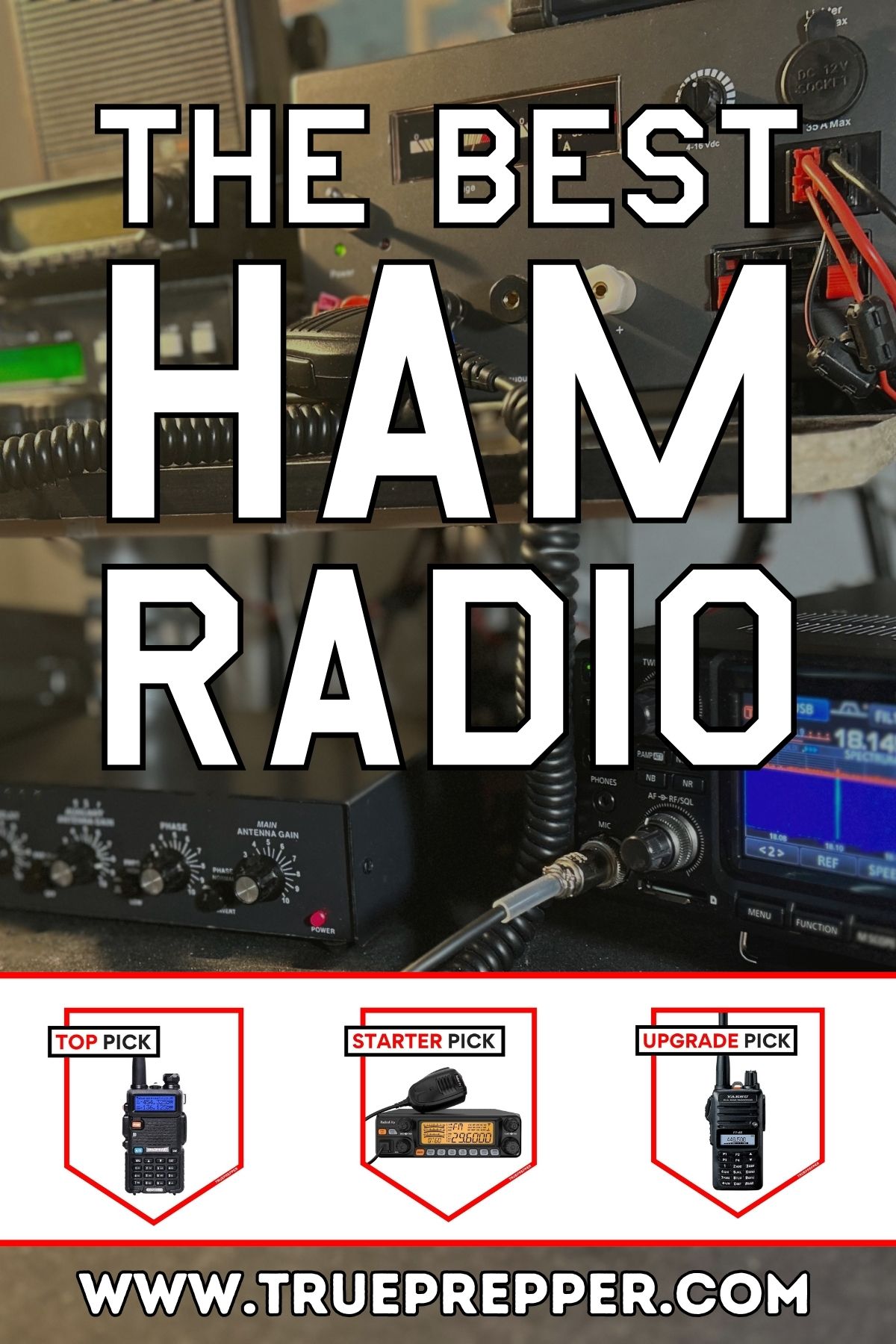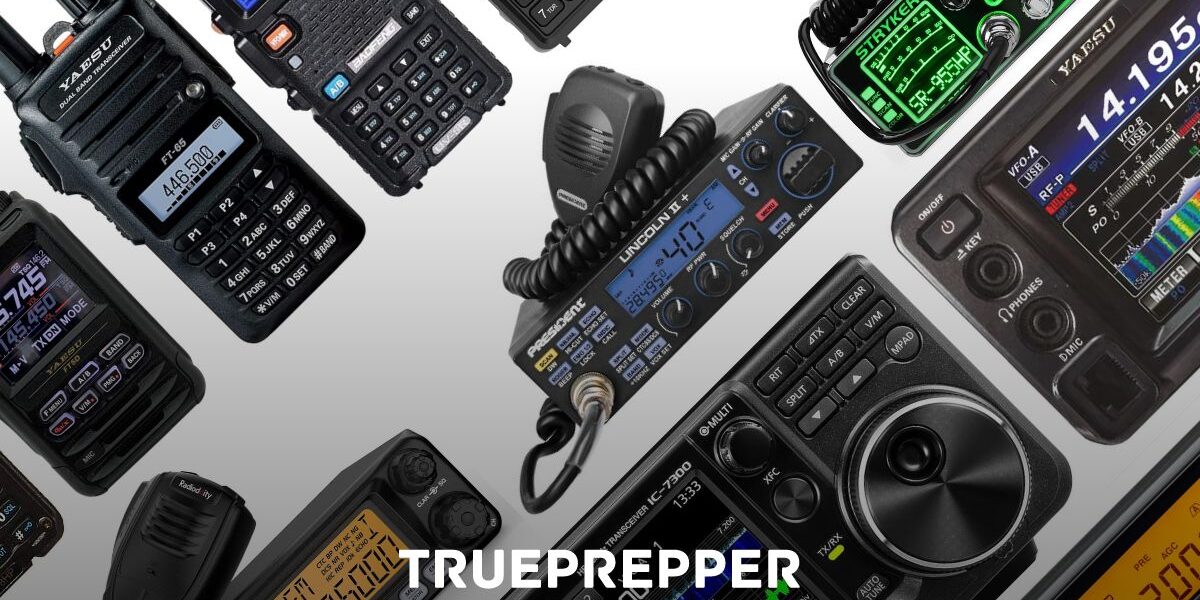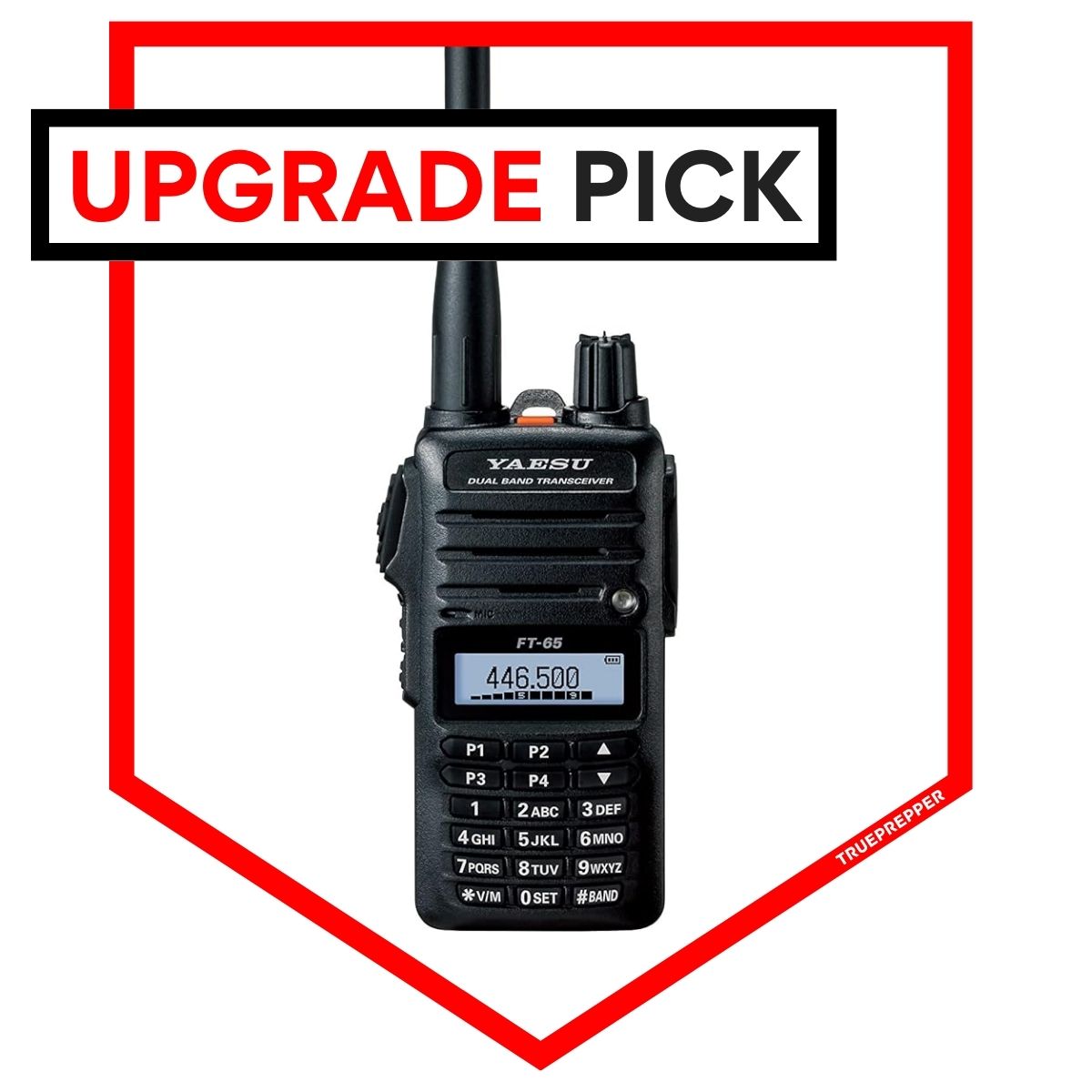Best Ham Radio for Preppers
Many consider amateur radio to be the best option for emergency communication. And they’d be right- you don’t need satellites or external infrastructure to talk all around the world. What you will need is plenty of time to learn, pass tests, and a license. And to get started? You’ll need a ham radio. There are plenty of brands, models, and types of amateur radios to consider.
This is where we come in. We’ve researched the best ham radios, compared them, and now the results are in: the overall best, an upgrade option, and a beginner option for a full base station setup. If you need to keep in contact or stay informed, one of our picks is your long-distance solution.
Contents (Jump to a Section)
The Best Ham Radio
Baofeng UV-5R
Inexpensive, Portable, and Effective
With value that simply can’t be beaten, the UV-5R has lowered the barrier to entry into the amateur radio world.
*Price at time of publishing; check for price changes or sales.
If you are looking to hop on a band and listen, stay informed during emergencies, or have a massively upgradeable portable radio, the tried-and-true Baofeng fits the bill. It’s not going to win any quality awards, but when you can buy five of these before you get even close to a comparable handheld, you can’t ignore the value.
Anyone and everyone interested in ham radios these days tends to start with the UV-5R because it is inexpensive enough for anyone to afford and dangerous enough to break all the rules. For this reason, you’ll see some anti-Baofeng sentiment in the amateur radio community since the effect this single radio has had on it is mixed.
The UV-5R is technically discontinued at this point, but it still is a better value than its successor with more features, the BF-F8HP.
Here is everything you get with this radio:
- 7.4V, 5W output (lower modes as well)
- IP54 dust/water protection
- 200 channel, PC programmable, UHF/VHF
- 1,950mAh lithium-ion battery
- 1.2″ D x 2.1″ W x 4.1″ H (without antenna)
- 3.9 ounces
With an unbeatable price and unlimited handheld customization, it’s easy to see why the Baofeng UV-5R Ham Radio tops the rest.
Beginner Ham Radio
Used HF Base Station
Powerful, Long-Distance, and Effective
With much higher costs, used is the way to go when outfitting your base station with an all-mode transceiver.
*Price at time of publishing; check for price changes or sales.
Base stations can be prohibitively expensive for some, especially since you’ll need to consider power supplies, tuners, antennas, wires, cables, and other gear to complete the setup. Used options can significantly lower the costs, and with the aging amateur radio community, it’s easier than ever to find quality gear on the used market.
Joining up with your local amateur radio club could help with your budget since most experienced hams have spare equipment and are more than happy to help out newcomers who are serious about getting involved. ARRL can point you to your closest amateur radio club where you’ll find hams running events, clubs, meetups, and contests. You’ll also find a lot of overlap with the prepping community.
If you are looking at setting up a base station, an all-mode transceiver can cost upwards of $1000 new, so you should be able to find a used one at a fraction of that depending on the age and features. A Used HF Base Station Transceiver is the ideal pick for any beginner to set up your base station to transmit around the globe.
Upgrade Ham Radio
Yaesu FT-65
Easy to Use, Versatile, and High Quality
This dual-band handheld is both reliable and durable as a top pick for licensed radio operators on the move.
*Price at time of publishing; check for price changes or sales.
Yaesu has a better reputation in the industry than cheaper portable options and their rugged little handheld proves the point. This radio reliably transmits, is easy to program, has plenty of versatility and customization options, and it’s rugged as hell.
Here is how it stacks up:
- 7.4V, 5W output (lower modes as well)
- IP54 dust/water protection
- 200 channel, PC programmable, UHF/VHF
- 1,950mAh lithium-ion battery
- 1.2″ D x 2.1″ W x 4.1″ H (without antenna)
- 3.9 ounces
If you are looking for a reliable full-featured handheld radio, the Yaesu FT-65 Ham Radio is the best option.
Everything We Recommend

With value that simply can’t be beaten, the UV-5R has lowered the barrier to entry into the amateur radio world.
Where to Buy
*at time of reviewing

With much higher costs, used is the way to go when outfitting your base station with an all-mode transceiver.
Where to Buy
*at time of reviewing
The Radios We Compared
Our research narrowed the field down to several brands of ham radios that we compared: Icom, Stryker, Yaesu, Baofeng, Retevis, Radioddity, Kenwood, and more.
You can see our full list of review criteria below in the What to Look For section, with an explanation for each.
We’re always looking for new and better gear, so if you have an amateur setup that will work well in emergencies, let us know in the comments. We review most of our tested gear annually so we can try to get it in the next roundup round and see if it will beat out our top picks.
What to Look For
The best ham radios have a few features to look for:
- Value
- Power/Range
- Ease of Use
- Size/Weight
- Versatility
When you get the right blend of these, you can find the perfect radio for your specific situation. Below, we break down what each of these features means for the models that truly set themselves apart.
Value: Cost vs. Benefit
The amount of money you spend on something like a radio shouldn’t blow out your entire budget. They come in a huge range of prices that mostly depend on the output power and features.
You never want to spend too much money on one resource, even when it comes to communication. It’s better to diversify your spending to make sure you are covered for a wide range of scenarios.
Power & Range
The power (measured in wattage) and the effective range are related but don’t tell the whole story. Still, when those are paired with the available bands, frequencies, and modes you can get a pretty good idea of how a radio will perform.
Handheld transceivers have much lower power than base stations and have limits to range unless you hit repeaters or other versatile options. Mobile stations aren’t much better, usually limited to 10m- so an all-mode base station transceiver is what you are looking for if you want to maximize the allowable power and range amateur radio has to offer.
Ease of Use
Technical knowledge is a big part of amateur radio, which is why there is a testing requirement to be able to transmit. Some of this knowledge is how to set up and operate a radio, which is not always intuitive, and be quite involved in base station setups.
Even handhelds are not always pre-setup and will need channels programmed using a PC and external software. Japanese radios (Icom, Kenwood, and Yaesu) are known for their quality and more intuitive setup and control. Chinese radios (Baofeng, Radioddity, Retevis, Btech) can be more difficult to set up and less intuitive to use. American-made radio brands (Elecraft, FlexRadio) don’t dip into handheld transceivers, so you are limited to overseas options to get started unless you go with a full base station rig.
Size & Weight
Base stations and mobile radios can weigh a few pounds, and rely on other external equipment to transmit and receive signals. This size and profile make them too unwieldy for carrying or including in survival kits, but the HTs (handheld transceivers) fit the bill.
HTs have much lower power than a base station, but are the size of FRS walkie-talkies and are still more powerful than those. Without the battery and antenna, you can find handhelds weighing less than half a pound and stowing away with a profile less than 4″ in every direction. Foldable antennas can give you great reception without a large profile as well.
Versatility
The versatility of a ham radio depends on the types of transmissions it can receive and/or transmit and a wide range of other factors. It is the most versatile radio option by far and has the potential to transmit across the globe with the right setup.
HAM vs. FRS, CB, & GMRS
Ham, GMRS, FRS, CB – there are many options when it comes to communicating with radio setups and they are more different than just the frequency/amplitude bands they rely on.
| Type | Name | Mode | Channels | Max Watts | License | Test |
|---|---|---|---|---|---|---|
| HAM | Amateur Radio | Any | Many | 1500W | Yes | Yes |
| FRS | Family Radio Service (Walkie Talkie) | FM | 22 | 2W | No | No |
| CB | Citizens Band Radio | AM | 40 | 4W | No | No |
| GMRS | General Mobile Radio Service | FM | FRS+8 | 50W | Yes | No |
Ham, or amateur radio, is the ultimate solution with the least amount of restrictions if you pass a test and obtain various levels of licenses.
Local clubs can usually administer the test, so that’s just another reason to reach out and make a connection. Otherwise, a few also offer online ham radio exams, where if you pass you can go on to register with the FCC and obtain your amateur radio license.
Who Needs a Ham Radio?
Most preppers are interested in ham radios because they are a self-sufficient solution for long-distance communication. You’ll need plenty of equipment and power to transmit those long distances, so costs can escalate quickly as you gear up.
For those who are just looking to get started, stay informed by listening on channels, or have backup comms on hand for emergencies- the inexpensive handhelds are perfectly reasonable.
Anything more than listening on a channel or transmitting below 2W on an FRS channel will require a license, but if you are getting into amateur radio you need to consider it anyway. Pursuing a license is a great way to learn about how radios work, the different ways to communicate, and even radio etiquette. Short-sighted preppers may say they won’t need a license when SHTF, but not every disaster includes societal collapse. Plus, you’ll be missing out on important resources like local clubs and events.
As far as survival kits, we recommend amateur radios for a wide range:
Your involvement in the amateur radio world can be as small or large as you want, thanks to accessible price points and widely customizable equipment.
How We Review Products: We research thoroughly before selecting the best products to review. We have vast prepping and survival experience and bring in outside experts when needed. Hours on end are spent testing gear in stressful conditions and using specialized testing gear to verify claims. We assign performance criteria and impartially rate each tested item. Learn more about how we test.
Sources and References
All of our experience and the testing we do to determine the best ham radios are useless without listing our research sources and references. We leaned on these for the book knowledge that we paired with our hands-on testing and practical survival experience:
Haring, K. (2003). The “Freer Men” of Ham Radio: How a Technical Hobby Provided Social and Spatial Distance. Technology and Culture. Volume 44. Issue 4. Pages 734 – 761. (Source)
Kinsner, W., et al. (2014). Enhanced crowdsourcing for disasters through ham-radio operators. IEEE Canada International Humanitarian Technology Conference – (IHTC), Montreal, QC, Canada. Pages 1-6. (Source)
Silver, H. (2021). Ham Radio for Dummies. John Wiley & Sons; Hoboken, NJ. (Source)
The Final Word
While texting is a solid plan when emergencies and disaster strikes, you should be prepared with alternate methods of communication. Amateur radios can be one of those alternate methods that can keep you connected in an emergency.
Here are a few other gear reviews and guides our subscribers have found helpful:
- The Best Survival Walkie-Talkie for Emergencies
- How Will You Communicate in an Emergency?
- Home Survival Kit List | 53 Essentials
We presented quite a lot of information, but as always: if you have any questions let us know and we would be happy to help. Our review found the Baofeng UV-5R Ham Radio to be the best solution given its value, power/range, ease of use, size/weight, and versatility.
Keep exploring, stay prepared, and be safe.
You’ve Been Missing Out
Join the 2+ million preppers that rely on our prepping advice by subscribing to TruePrepper.- Practical guides and tips
- Useful survival giveaways
- Free, forever
- < 0.4% of people unsubscribe



